Cells grafted into the eye restore sight to blind mice, three genes can convert scar tissue back into beating cardiac muscle following a heart attack and electrical stimulation that returns movement to limbs paralysed by spinal injury. Plus nanoparticles to deliver drugs to treat cerebral palsy and a new technology to boost the reach of RFID tags for real time long-range tracking...
In this episode
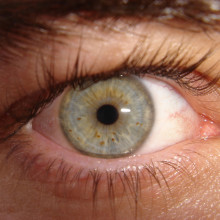
00:16 - Rod transplants restore sight to blind mice
Rod transplants restore sight to blind mice
Rod precursor cells transplanted from the eyes of newborn mice into blind adult animals can restore vision, UK scientists have shown.
Working at UCL and publishing their results in Nature, researcher 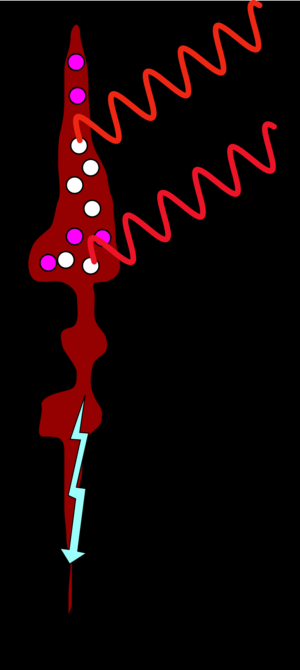 Robin Ali and his team used adult mice lacking a gene called Gnat1, which prevents the animals' rod cells from working, triggering night blindness. Into a group of these animals the scientists injected beneath their retinae 200,000 developing rod cells collected from 4-8 day-old donor mice.
Robin Ali and his team used adult mice lacking a gene called Gnat1, which prevents the animals' rod cells from working, triggering night blindness. Into a group of these animals the scientists injected beneath their retinae 200,000 developing rod cells collected from 4-8 day-old donor mice.
These donor cells expressed a genetic label to enable them to be distinguished from the recipients' cells. The result, three weeks later, was up to 26,000 new rod cells in each recipient retina, with most of the new rods clustered around the injection site.
Examined under the microscope, the new rods appeared to have wired themselves into the host retinae correctly and responded appropriately to flashes of light. Compared with control animals that showed no responses, the visual areas of the treated animals' brains also altered their activity in response to light stimuli and the animals could follow moving light spots with their eyes, proving that signals from the grafted rod cells were being appropriately transmitted into the nervous system.
The treated mice were also able 70% of the time to locate a hidden platform in a water maze under low-light conditions. Control animals trying the same task performed no better than chance.
According to the scientists, "the results demonstrate for the first time that transplanted rod-photoreceptor precursors can integrate into a dysfunctional adult retina and, by directly connecting with the host retinal circuitry, truly improve vision."
Some commentators remain sceptical, however, criticising the the work on the grounds that the Gnat-1 mutant mice used still have functioning cones in their retinae and also have rods that could be rendered functional by the injected precursor cells.
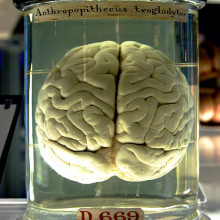
04:09 - Getting to Grips with Treating Paralysis
Getting to Grips with Treating Paralysis
With over 130,000 people suffering some paralysis as a result of spinal injury each year, devices that can bypass the spine and convert brain activity directly into coordinated movement could immeasurably improve thousands of lives. Now, research at the University of Pittsberg and Northwestern University has done just that - returning the ability to grip a ball to partially paralysed monkeys.
Functional Electrical Stimulation, or FES, has been extensively studied and deployed as a way to restore movement to paralysed limbs. The technique involves using electrodes to simulate the signals from the brain and stimulate muscles directly. Clinical systems already exist that can return limited gripping ability to patients, but these generally involve tapping into the activity of a nearby healthy muscle, and learning to use that to control the hand in a simple pinch motion. Returning the full use of the hands would be life changing.
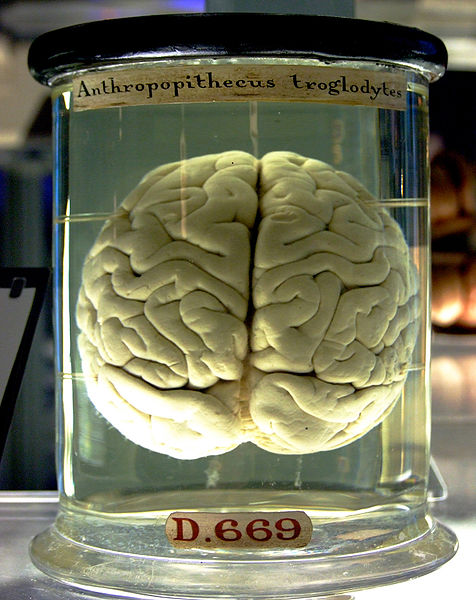 Writing in Nature, Lee Miller and colleagues describe how they measured the electrical activity in the hand region of the primary motor cortex of monkeys as they completed some simple tasks. Importantly, they also measured the electrical activity in the muscles that controlled the hand and forearm, allowing them to link the brain and muscle activity and therefore predict how the muscles should move in response to electrical signals in the brain.
Writing in Nature, Lee Miller and colleagues describe how they measured the electrical activity in the hand region of the primary motor cortex of monkeys as they completed some simple tasks. Importantly, they also measured the electrical activity in the muscles that controlled the hand and forearm, allowing them to link the brain and muscle activity and therefore predict how the muscles should move in response to electrical signals in the brain.
The monkeys' two tasks were simple, but needed some fine control of grip. In one task, the monkeys had to pick up a ball roughly the size and weight of an apple, and drop it into a collecting tube to get a reward. The second task measured control of how hard the monkey was gripping, and involved squeezing a flexible tube with a particular strength for a given length of time.
Once the monkeys were trained, and their brain and muscle activity measured, the symptoms of a spinal injury were temporarily mimicked by knocking out the nerves in the elbow with anaesthetic. The researchers then used functional electrical stimulation along with their predictions of the response to brain activity in order to activate the muscles in real time.This allowed the monkeys to complete both tasks again, showing that this technique can return not just a binary on/off gripping motion, but also the fine control needed to modulate grip strength. This effectively bypassed the spinal cord completely.
Knocked-out nerves are a simplistic model of spinal injury, so this will take some development before we see it in use in human patients, but this is a major step forward and proof of principle for brain-controlled functional electrical stimulation.
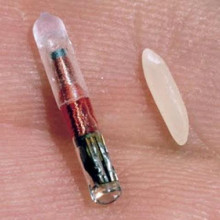
07:36 - Reaching Further with RFID
Reaching Further with RFID
Dr Sithamparanathan Sabesan, Cambridge University
Chris - If you've ever walked out from a shop and set off an alarm - I'm sure you haven't for anything other than accidental reasons - then you've probably triggered an RFID, that's Radio Frequency ID tag system. The problem with these tags is that although they can identify an individual piece of merchandise and are therefore very useful, they only work over very short distances and that limits their use.
But now, new research from Cambridge University has found a way to dramatically increase this range and therefore, the usefulness of these pieces of equipment. To tell us more, Sithamparanathan Sabesan who is from Cambridge University's department of engineering where he's a research fellow, is with us to tell us how it works. First of all, thanks for joining us. What do these RFID tags actually do? How do they do what they do?
Sithamparanathan - RFID stands for Radio Frequency Identification. These RFID tags do not have an internal power source, you have to power them up for them to receive signal and retransmit signal for example. And so, we have antennas. They transmit an electromagnetic signal for them to basically receive the signal. And these RFID tags then have a unique ID stored in the microchip.
Chris - So, the energy comes in from a radio signal from a transmitter. It interacts with the tag which gets its energy from that, powers up a little microchip which sends a unique radio signal back to a detector and that says, "Hi. Here I am" and identifies that item uniquely.
Sithamparanathan - Absolutely.
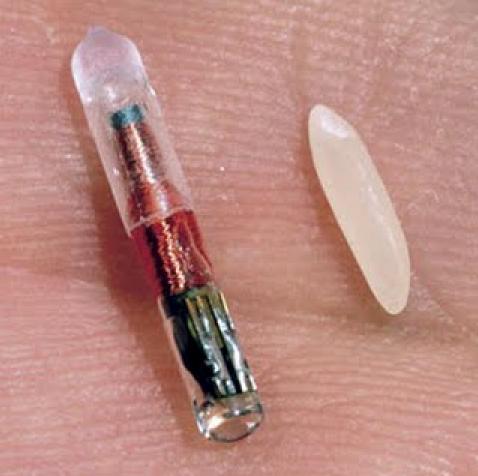 Chris - So that sounds terrific. What is the problem with these tags? Why are they an issue?
Chris - So that sounds terrific. What is the problem with these tags? Why are they an issue?
Sithamparanathan - The real challenge here is then, because they don't have a battery, it's very difficult for us to read this tag over longer distance, due to the fact that the signal not only travels in one single direction, but also, travels in multiple directions.
Chris - Because of in reflections off of walls and the floor, and so on.
Sithamparanathan - Exactly. So the results of that, the direct signal gets cancelled out by the reflected signals.
Chris - So this is the signal coming in from the transmitter that you're beaming to the tags. It will bounce off all the surfaces and in certain places, you're going to cancel out the signal and get a dead spot.
Sithamparanathan - Exactly and we call them dead spot. The reality is that, over a large area, you'll have so many dead spot that typically, you can only read 60% of the tags in a conventional approach. And so, we developed a technology called dithering. We have multiple transmitters, they synchronise in a way that we are able to move this dead spot around within that area. As a result of that, I shall be able to read this tag with 100% accuracy. I won't miss any single tag over that large area.
Chris - Wow! So, where previously with a static array of transmitters, you would end up with a pattern of dead spots. It's a bit like if you walk around your house with a mobile phone, it works in some rooms and not others. You've got a pattern of dead spots and so, if the tag is in one of those, you're not going to spot it. But with your system, you're moving the dead spots around in the environment, dithering them. So, even if a tag is in a dead spot one moment, the next moment it's not and you're going to get the signal back. And so, the trick is how you move the dead spots then?
Sithamparanathan - So we use multiple transmitters in a synchronised way by doing some clever advance signal processing at the backend and also synchronise them. These are able to move these dead spot very quickly because you got to move them very fast. It's typically in milliseconds kind of speed. By doing so, over the 1 second period, I shall able to read all the single tags.
Chris - And this means that then, rather than just having to put in massively powerful transmitters which still wouldn't get around the dead spot problem, you've now got a simple array, you use these very cheap tags and you can detect them over, I would say, probably much greater distances as well then.
Sithamparanathan - Yes. So far, we have demonstrated over 20-meter x 20-meter area with 100% accuracy. You could scale that to a large building, typically hundreds and hundreds of meter large buildings, you could have a small number of antennas and read all the tags over that area.
Chris - How do you actually read where the tags are? In order to scale it over a very big area like that, you're detecting a tiny signal coming out from a tag which could be anywhere in that environment? So is that a sort of triangulation trick then?
Sithamparanathan - Exactly. So, in order to locate the tags, that's another challenge. Reading a tag is one challenge we just discussed and locating the tags is another challenge. You could have triangulation. Even then, you're still going to have the multipath and dead spot problem, but we have another invention which enable us to triangulate these tags in a novel way. The results of that is that you can locate these tags within 1 meter location accuracy.
Chris - So supermarkets are going to be delighted because I'm thinking, all I need to do is I go into the supermarket, swipe my credit card and identify myself electronically to the supermarket with a sort of trolley or something and then every time I take something off the shelf, the supermarket knows where the object is because you can have these tags on every piece of stock. So a.) It's good for stock control, b.) It stops shoplifting, and c.) It means that I don't have to queue up and check out. I just walk out.
Sithamparanathan - Exactly, so supermarket automatic checkout is one of the long term visionary application we're focusing on. As you said, in the future, you don't need to stand in a queue. You just walk with your trolley and pass through that reader and it will give you the bill straight away, there's no queue whatsoever. But there are other applications we're currently launching, one of which is document tracking. Working with local councils where they want to see where every single file is within large office area...
Chris - I think also in a hospital because tracking down a patient's notes - it sounds trivial but if you're in the operating theatre and the notes are on the other side of the hospital, knowing where they are to send someone to get them could be really helpful.
Sithamparanathan - I'm glad that you mentioned hospitals because that's one of the customers we've been speaking with very recently. They will also want to track their patients because they also want to learn how their diseases spread within hospitals.
Chris - Have you got any trial data to show that this will actually work though? It's one thing to say, "Right, we think we can do this in supermarkets, we think we can make this work in a hospital to track people and notes." What about the reality though? Have you got data on this?
Sithamparanathan - So very recently, we have developed and demonstrated for the first time a document tracking system. We were able to show that we were reading hundreds of files over that large area. We were demonstrating over 20-meter x 20-meter area. There's also another big launch that happened in London last week, for tracking containers and cars in over a large area and so, so far, we have a prototype system which is able to show that we have 100% coverage over that large area for the first time.
Chris - Amazing stuff, thank you very much. That's Sithamparanathan Sabesan, from the Department of Engineering at Cambridge University.
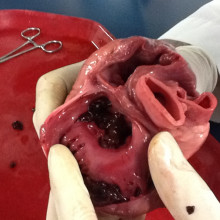
14:23 - Scar tissue re-programmed to become beating heart cells
Scar tissue re-programmed to become beating heart cells
Scar tissue in injured hearts can be converted back into healthy cardiac muscle using gene therapy, US scientists have shown.
Following a heart attack, some of the muscle tissue that  generates the pumping action needed to push blood around the body is replaced by an immobile fibrous scar.
generates the pumping action needed to push blood around the body is replaced by an immobile fibrous scar.
If it's sufficiently extensive this can compromise the function of the heart, causing heart failure. The scarred areas may also affect the way that the electrical signals that coordinate the heartbeat travel through the tissue, triggering abnormal rhythms and even cardiac arrest. And because heart muscle doesn't naturally replace itself after an injury, these consequences were thought to be permanent.
Now, writing in Nature, Deepak Srivastava and his colleagues at the Gladstone Institute of Cardiovascular Disease in San Francisco may have found a way to convert the fibroblast cells that form scar tissue back into beating heart cells, in-situ.
The discovery hinges on three genes called Gata4, Mef2c and Tbx5; these are known as "GMT" and have been shown previously to operate during the embryonic development of the heart to direct the formation of heart muscle cells known as cardiomyocytes.
By engineering these genes into disabled viruses, which were then injected into the damage parts of the hearts of experimental mice that had had recent heart attacks, the team successfully reduced the sizes of the scars that subsequently formed in the animals' hearts and demonstrated that, compared with controls, the animals had improved cardiac function as a result.
A dose of about 100 million virus particles was able to hit about 300,000 cells, converting about 12% of them into new cardiomyocytes. And because the technique labelled-up the newly-re-programmed cells, the scientists were able to confirm their origins and test their function.
The cells wired themselves apropriately to adjacent cells and contracted when electrically activated. They also had the correct appearance, genetic and biochemical profiles.
In their paper the team conclude, "The ability to regenerate adult heart tissue from endogenous cells is a promising approach to treating cardiac disease that may face fewer obstacles to clinical translation than other approaches..."
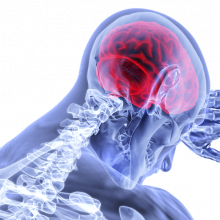
16:41 - Nanoparticle drugs for Cerebral Palsy
Nanoparticle drugs for Cerebral Palsy
Drugs attached to nanoparticles reduce the symptoms of Cerebral Palsy in rabbits if given soon after birth, by getting into the brain and targeting just the cells involved in the disease. This opens the door to treatments for a range of neuroinflammatory diseases including Alzheimer's disease and multiple sclerosis.
Cerebral palsy is an umbrella term for a suite of disorders, all of which stem from an injury or insult to the developing brain and affect muscle coordination, cognition and sensory acuity. Once Cerebral Palsy is diagnosed, it's usually too late to treat the brain injury itself, so current treatments concentrate on easing the symptoms.
It's thought that two cell types are involved in the pathology of cerebral palsy - Microglia and astrocytes. Microglial cells are part of the immune system that police the brain and spinal cord, and in Cerebral palsy are thought to be the cause of inflammation. Astrocytes are essentially neuron support cells, but fail to protect nerve cells in situations of inflammation.
Writing in the journal Science Translational Medicine, Sujatha Kannan from Wayne State University and colleagues describe how these cells, normally protected by the blood-brain barrier, can be targeted by attaching drugs to branching nanomaterials known as dendrimers - which are already being investigated as a targeted delivery mechanism in cancer and other diseases. The drug they were using was NAC (N-acetyl-L-cysteine), a known antioxidant and anti-inflammatory agent which is also being tested as a treatment for Alzheimer's and Autistic spectrum disorders.
The drug, linked to its dendrimers, was delivered to new-born rabbits that showed neuroinflammation and motor deficits, a good model of human cerebral palsy. A single dose led to a significant improvement in brain injury and motor function, whereas the drug without its nano-partner did not, suggesting that the dendrimers are key to getting the drug to where it's needed.
This shows that there is a potential window for treating the brain injuries that lead to cerebral palsy, but we therefore need better ways of identifying those at risk early on. According to the authors, "targeted therapy ... in at-risk patients, delivered at an early stage after birth, can potentially arrest or prevent the development of motor and cognitive deficits associated with perinatal brain injury and cerebral palsy."
This is also a good test of nanoscale dendrimers as drug delivery agents, and gives us good reason to look forward to the results of other trails testing these in a wide range of diseases.

19:12 - Water Sources in Africa and Orangutan Engineers
Water Sources in Africa and Orangutan Engineers
Helen Bonsor, British Geological Survey; Graham Hardie, University of Dundee; Bernard Kippelen from the Georgia Institute of Technology; Roland Ennor, University of Manchester
New Water Source Revealed throughout Africa
Water availability across Africa could be improved significantly by tapping into reservoirs of groundwater.
Writing in the journal Environmental Research Letters, Helen Bonsor from the British Geological Survey collated data from regional maps and scientific literature and mapped the potential yield of groundwater across the African continent. The findings estimated the total volume available to be 0.66 million km2, more than 100 times that available on the surface annually. However, levels were found to vary greatly in different regions.
Helen - The amount of groundwater available in Africa varies considerably and it's not available for widespread development of high yielding bore holes across the continent. There's only large volumes of groundwater stored in North Africa, so in Libya, Chad, Algeria. In Sub-Saharan Africa, where most of the population live, there's actually much lower groundwater volume stored there. If it's exploited very carefully then it is possible that groundwater could support small scale drinking water supplies where there are 300 million people who don't have basic access to water.
New Disease Targets for Aspirin
A new effect of aspirin in the human body has been discovered by scientists at the University of Dundee. Once consumed, aspirin is rapidly broken down into the compound salicylate. When applied to human cells in the lab, Graham Hardie found that high concentrations of this compound activated the enzyme AMPK - a regulator of cell growth and metabolism. It's thought this effect of aspirin, away from its pain-killing properties, could be beneficial against a range of diseases, including cancer...
Graham - It's been found that the people who take aspirin long term tend to have a lower incidence of cancer. So, it's at least possible that the effects of taking regular aspirin on cancer might not be mediated by the sort of classical target, but might be mediated instead by this new target which is AMPK. We haven't proved that yet, but it raises an exciting prospect that this very old drug might actually have some new applications.
Polymer for cheaper solar cells
A new polymer could enable cheaper, easy to produce solar cells. To be able to generate electricity, organic electronics, such as solar cells, require the use of materials that receive and release electrons readily. This usually means the use of conductors such as calcium or magnesium which are highly reactive with air and water and as a result are coated with thick, expensive materials to stabilise them. But now, a new polymer developed by Bernard Kippelen from the Georgia Institute of Technology has been shown to achieve this property in less reactive materials when applied to them as a thin coating...
Bernard - These polymers are air stable, so they don't degrade in contact with air, and we hope that the use of air stable materials in the field of organic photovoltaics will accelerate the deployment of these technologies through reduced cost and simpler manufacturing.

Orangutan Engineers
And finally, orangutans use advanced engineering skills when building their nests, according to scientists at the University of Manchester. By observing 14 orangutan nests in Sumatra, the team found that strength, flexibility and comfort were taken into account by the apes with different branch types being used for various aspects of design. Thick branches were only half split and weaved together to make a strong basket-like structure, and thinner branches used to construct a comfortable lining to sleep on. Roland Ennos is a senior member of the research team.
Ronald - Orangutans are much more sophisticated in their use of branches in producing nests than we hitherto have thought. They seem to have some knowledge of the properties of the wood and how it will break, and they make best use of those properties. And this has implications for the evolution of intelligence. It suggests that we are not the only toolmakers and that the evolution of intelligence might be related to the ability of organisms to manipulate their mechanical environment, not just their social environment.
The work was published in the journal PNAS.










Comments
Add a comment